Low-Maintenance Trees and Palms
Trees and palms are a staple in many landscapes. They provide shade and shelter, improve air quality, and mitigate flooding. Keep reading to learn about some trees and palms that require minimal watering and care in Sarasota County (UF/IFAS Gardening Solutions).
Note: The following information is adapted from the Florida-Friendly Landscaping™ Plant Guide.
Legend
Apart from the information presented in the table, the following features will be highlighted under each plant’s picture.
Light
 : At least 6 hours of full sun
: At least 6 hours of full sun
 : 2-4 hours of full sun per day
: 2-4 hours of full sun per day
 : Full shade
: Full shade
Perks
 : Attracts pollinators
: Attracts pollinators
 : Attracts birds
: Attracts birds
 : Edible parts*
: Edible parts*
Geography
 : Native
: Native
 : Non-native
: Non-native
Trees and Palms
Cabbage palm (Sabal palmetto)
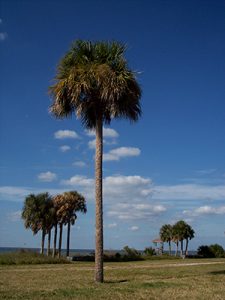






| Height | 25 to 60 feet |
| Growth Rate | Slow |
| Hardiness | 8B to 11 |
| Light Requirement | Full to partial sun |
| Salt Tolerance | High |
| Drought Tolerance | High |
| Soil Preference | Tolerates wide range of soil pH (4.5-8.0), well-drained to wet |
| Comments |
|
Read more here.
Peregrina (Jatropha integerrima)
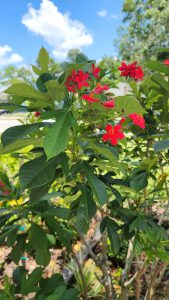





| Height | 8 to 15 feet |
| Growth Rate | Moderate |
| Hardiness | 9B to 11 |
| Light Requirement | Full to partial sun |
| Salt Tolerance | Low |
| Drought Tolerance | High |
| Soil Preference | Tolerates wide range of soil pH (4.5-8.0), well-drained |
| Comments |
|
Read more here.
Coral plant (Jatropha multifida)
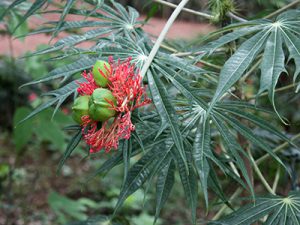





| Height | 8 to 15 feet |
| Growth Rate | Moderate |
| Hardiness | 9B to 11 |
| Light Requirement | Full to partial sun |
| Salt Tolerance | Low |
| Drought Tolerance | High |
| Soil Preference | Tolerates wide range of soil pH (4.5-8.0), well-drained |
| Comments |
|
Read more here.
Frangipani (Plumeria rubra)




| Height | 20 to 25 feet |
| Growth Rate | Slow |
| Hardiness | 10A to 11 |
| Light Requirement | Full to partial sun |
| Salt Tolerance | High |
| Drought Tolerance | High |
| Soil Preference | Tolerates wide range of soil pH (4.5-8.0), well-drained |
| Comments |
|
Read more here.
Seagrape (Coccoloba uvifera)
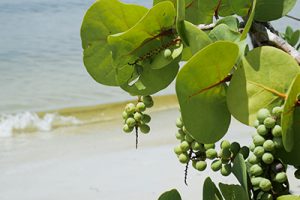






| Height | 3 to 35 feet |
| Growth Rate | Moderate |
| Hardiness | 9A to 11 |
| Light Requirement | Full to partial sun |
| Salt Tolerance | High |
| Drought Tolerance | High |
| Soil Preference | Acidic to slightly alkaline (4.5-7.2), sandy clay, well-drained |
| Comments |
|
Read more here.
Powderpuff (Calliandra spp.)
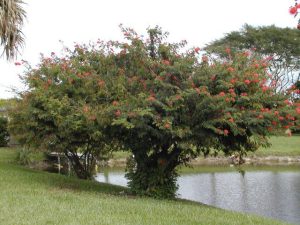




| Height | 10 to 15 feet |
| Growth Rate | Fast |
| Hardiness | 9A to 12 |
| Light Requirement | Full to partial sun |
| Salt Tolerance | Low |
| Drought Tolerance | High |
| Soil Preference | Slightly acidic to slightly alkaline (6.0-7.2), well-drained to wet |
| Comments |
|
Read more here.
Floss silk tree (Chorisia speciosa)
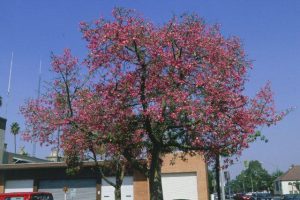


| Height | 35 to 50 feet |
| Growth Rate | Fast |
| Hardiness | 9B to 11 |
| Light Requirement | Full sun |
| Salt Tolerance | Low |
| Drought Tolerance | High |
| Soil Preference | Tolerates wide range of soil pH (4.5-8.0), medium to well-drained |
| Comments |
|
Read more here.
Fiddlewood (Citharexylum spinosum)
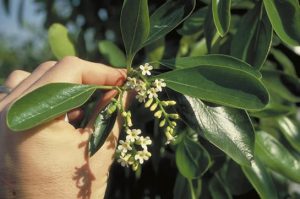





| Height | 15 to 25 feet |
| Growth Rate | Slow |
| Hardiness | 9A to 11 |
| Light Requirement | Full to partial sun |
| Salt Tolerance | Medium |
| Drought Tolerance | High |
| Soil Preference | Acidic to slightly alkaline (4.5-7.2); well-drained |
| Comments |
|
Read more here.
White geiger (Cordia boissieri)
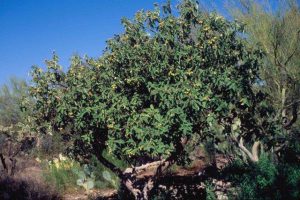




| Height | 15 to 20 feet |
| Growth Rate | Slow |
| Hardiness | 9A to 11 |
| Light Requirement | Full to partial sun |
| Salt Tolerance | Medium |
| Drought Tolerance | High |
| Soil Preference | Slightly acidic to alkaline (6.0-8.0), well-drained |
| Comments |
|
Read more here.
Yaupon holly (Ilex vomitoria)
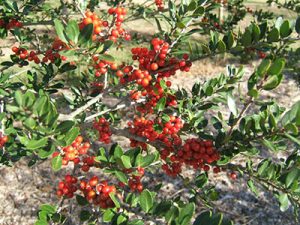






| Height | 15 to 30 feet |
| Growth Rate | Moderate |
| Hardiness | 7A to 10B |
| Light Requirement | Full to partial sun |
| Salt Tolerance | High |
| Drought Tolerance | High |
| Soil Preference | Acidic to alkaline (4.5-7.2), well-drained to wet |
| Comments |
|
Read more here.
Simpson’s stopper (Myrcianthes fragrans)
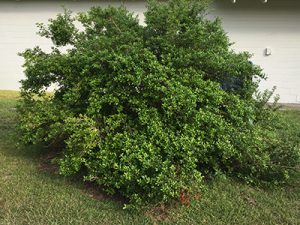







| Height | 6 to 30 feet |
| Growth Rate | Moderate |
| Hardiness | 9B to 11 |
| Light Requirement | Full sun to full shade |
| Salt Tolerance | High |
| Drought Tolerance | High |
| Soil Preference | Slightly acidic to slightly alkaline (6.0-7.2), well-drained to wet |
| Comments |
|
Read more here.
Gumbo limbo (Bursera simaruba)
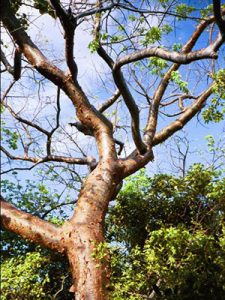





| Height | 20 to 50 feet |
| Growth Rate | Fast |
| Hardiness | 10A to 11 |
| Light Requirement | Full to partial sun |
| Salt Tolerance | Medium |
| Drought Tolerance | High |
| Soil Preference | Slightly acidic to alkaline (6.0-8.0), well-drained |
| Comments |
|
Read more here.
Chickasaw plum (Prunus angustifolia)
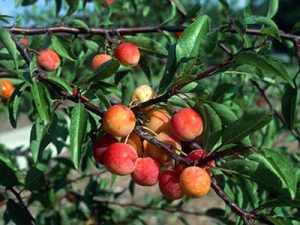






| Height | 12 to 20 feet |
| Growth Rate | Moderate |
| Hardiness | 6A to 9B |
| Light Requirement | Full to partial sun |
| Salt Tolerance | Medium |
| Drought Tolerance | High |
| Soil Preference | Acidic to slightly alkaline (4.5-7.2), well-drained |
| Comments |
|
Read more here.
Pink trumpet tree (Tabebuia heterophylla)



| Height | 20 to 30 feet |
| Growth Rate | Moderate |
| Hardiness | 9B to 12 |
| Light Requirement | Full sun |
| Salt Tolerance | Medium |
| Drought Tolerance | High |
| Soil Preference | Tolerates wide range of soil pH (4.5-8.0), well-drained |
| Comments |
|
Read more here.
Walter’s viburnum (Viburnum obovatum)
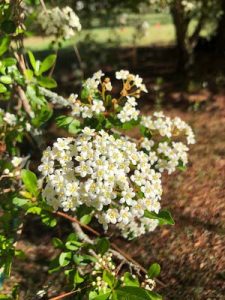






| Height | 8 to 25 feet |
| Growth Rate | Moderate |
| Hardiness | 9A to 10A |
| Light Requirement | Full sun to full shade |
| Salt Tolerance | Low |
| Drought Tolerance | High |
| Soil Preference | Tolerates wide range of soil pH (4.5-8.0), well-drained |
| Comments |
|
Read more here.
Silver buttonwood (Conocarpus erectus var. sericeus)





| Height | 5 to 50 feet |
| Growth Rate | Moderate |
| Hardiness | 10B to 11 |
| Light Requirement | Full to partial sun |
| Salt Tolerance | High |
| Drought Tolerance | High |
| Soil Preference | Slightly acidic to alkaline (6.0-8.0), well-drained |
| Comments |
|
Read more here.
Live oak (Quercus virginiana)
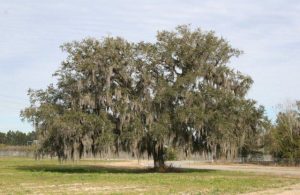






| Height | 40 to 80 feet |
| Growth Rate | Moderate |
| Hardiness | 7A to 10B |
| Light Requirement | Full to partial sun |
| Salt Tolerance | High |
| Drought Tolerance | High |
| Soil Preference | Slightly acidic to alkaline (6.0-8.0), medium to well-drained |
| Comments |
|
Read more here.
If you want to learn about other low-maintenance plants for your landscape, read the rest of our Low-Maintenance Landscaping blog series.
*Although we discuss edibility in this blog, UF/IFAS Extension Sarasota County is not responsible for any illness or injury associated with foraging. Be aware that some plants may have been treated with pesticides and are not fit for human consumption. Always exercise caution.
 1
1
